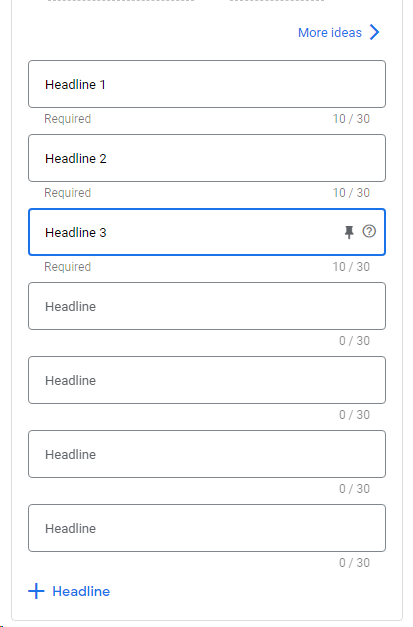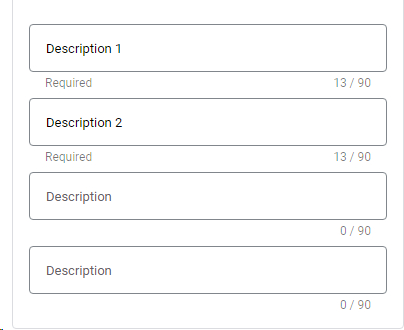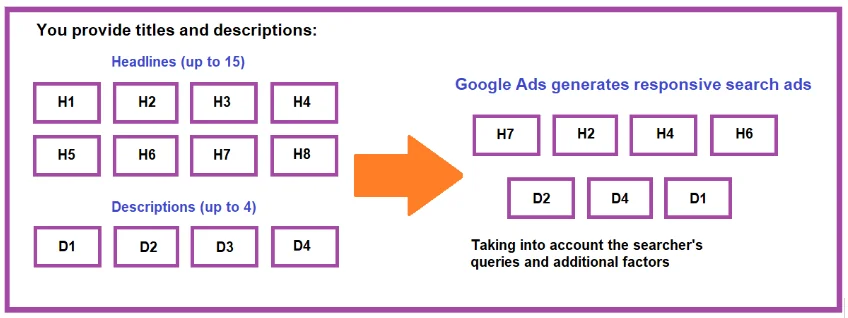How does Google Ads generate responsive search ads?
Author - Constantin Nacul
What are Responsive Search Ads?
Responsive Search Ads (RSA) are an advanced advertising feature of Google Ads that allows advertisers to create more flexible and effective advertising campaigns. RSAs are designed to automatically test different combinations of headlines and descriptions to determine which combinations perform best, optimizing ad content for various search queries and user preferences.
How does Google Ads generate responsive search ads?
Google Ads creates Responsive Search Ads (RSA) by automatically combining different headlines and descriptions you provide. This process can be broken down into several steps:

1. Data input
You enter multiple variants of headlines and descriptions. Google Ads allows you to add up to 15 headlines and 4 descriptions.
2. Automatic testing
The platform automatically tests different combinations of these headlines and descriptions to determine which ones best match the search criteria and advertising campaign goals.
3. Optimization
The system identifies the most effective combinations based on ad performance, including click-through rate (CTR) and conversion. This means that ads automatically adapt to show the most promising content for your target audience.
Contextual adaptation:
Responsive search ads also adapt to the context of the user's search query. This means that Google Ads selects the most relevant headlines and descriptions that match a specific query or user interests, thus improving the personalization of the ad.
5. Machine learning
All this is made possible thanks to machine learning algorithms that analyze large volumes of data on user behavior and ad performance to maximize the results of advertising campaigns.
Using responsive search ads allows advertisers to increase the reach and effectiveness of their campaigns by optimizing ads for each specific search query, without the need to manually test each combination of headlines and descriptions.
Responsive search ads examples
Let's say you are running an advertising campaign for an online storeselling sports goods. Here are some examples of headlines you could use to create responsive search ads in Google Ads:

Headlines:
- Buy sports equipment online
- Your sporting goods store
- Large selection of sporting goods
- Discounts on sports equipment
- Everything for fitness and sports
- Free delivery of sporting goods
- Find the perfect sports equipment
- Special offers on sports equipment
- High quality sports equipment
- Order sporting goods right now
Descriptions:
- A wide range of high-quality sports equipment at affordable prices.
- Free nationwide delivery - fast and convenient.
- Exclusive discounts and promotions for our customers.
- Everything you need for sports and active leisure.

Examples of combinations of headlines and descriptions:
- Buy sports equipment online + A wide range of quality sports equipment at affordable prices.
- A large selection of sports goods + Free nationwide delivery - fast and convenient..
- Discounts on sports gear + Exclusive discounts and promotions for our customers.
- Everything for fitness and sports + Everything you need for sports and active leisure.
- Find the perfect sports equipment + Quality sports equipment at affordable prices.

Google Ads will automatically test these and other combinations of headlines and descriptions you provide to determine which ones work best for different search queries and users. This allows you to maximize the effectiveness of your advertising campaigns, increasing the likelihood of clicks and conversions
Using AI in Creating and Optimizing Responsive Search Ads in Google
The use of AI in creating and optimizing Responsive Search Ads in Google Ads allows advertisers to significantly enhance the efficiency of their campaigns, reduce the time and effort spent on manual tuning and analysis, and offer more personalized and engaging content to potential customers.
Let's consider a specific example illustrating how artificial intelligence (AI) can improve the process of creating Responsive Search Ads in Google Ads, enhancing their efficiency and relevance.
Initial situation:
You manage an online store that sells specialized sports nutrition. The goal of your campaign is to increase sales of protein bars.
Without the use of AI:
You create several variants of headlines and descriptions based on assumptions about what might interest your target audience. You test these variants over several weeks, analyze the results, and make manual adjustments. This process takes a lot of time and requires constant attention.
With the use of AI:
Step 1: Automatic creation and testing
- AI analyzes historical data: User behavior, popular search queries, previous ad performance for similar goods.
- Generation of variants: Based on this analysis, AI generates multiple variants of headlines and descriptions, assuming some of them may best match the interests of the target audience
Step 2: Real-time personalization and optimization
- Contextual personalization: AI determines which combinations of headlines and descriptions are most relevant to specific users in real-time, considering their search queries and interests.
- Dynamic optimization: The system continuously monitors ad performance and automatically adjusts displays, preferring the most successful options
Usage example:
- For users searching for information on recovery after workouts, AI selects ads emphasizing the benefits of protein bars for muscle recovery.
- For people interested in weight loss, ads highlight the low sugar content and high protein composition of the bars
- AI tracks seasonal trends: for example, an increase in interest in fitness during the New Year period and adapts advertising messages to motivate buyers to start the new year with healthy nutrition purchases.
Thus, the use of AI not only automates the creation and testing of different ad variants but also significantly increases their relevance and efficiency, adapting to the needs and interests of specific users in real time. This leads to an increase in ad click-through rate (CTR), conversion rate, and, as a consequence, sales growth with lower advertising costs.

